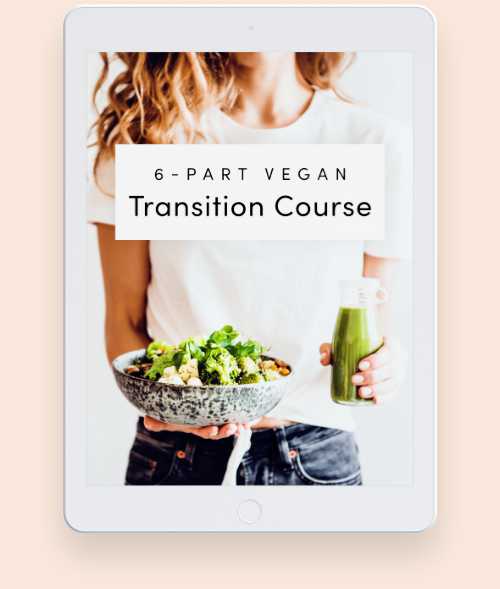Learn about the different types of plant-based diets to determine which one is right for you! Including recipe ideas and free guides.
If there’s one thing all reputable health experts and organizations can agree about, it’s that we should eat more plants.

join our free vegan course!
Learn how to thrive on a plant-based diet with practical tips & a 3-day meal plan!
From going dairy-free to ditching meat or simply reducing one’s intake of animal products, this can have many faces!
The reasons for eating plant-based are manifold: it’s kinder to the animals, better for our health and reduces our environmental footprint.
Find out more about the main types (and subtypes) of plant-based diets in this article to see where you fall on the spectrum!
If you want to go vegan, read more about different vegan diets here.
Vegan diet
A vegan diet is a “strict vegetarian diet” and doesn’t allow any animal products. That means no meat, fish, dairy, eggs or honey.
Veganism as a whole refers to a lifestyle and not only to the food on someone’s plate!
Vegans also don’t consume any items containing animal products, from personal care and cosmetics to furniture, clothing and more.
They also avoid products that have been tested on animals, don’t go to zoos and don’t ride horses.
People may follow a vegan diet for different reasons, from ethical to environmental, health or religion.
Vegans eat fruits, vegetables, grains, legumes, nuts, seeds, herbs, spices and all foods made from them! They also need to take Vitamin B12 to ensure adequate nutrition.
Whole food plant-based diet
A whole food plant-based diet is stricter than a vegan diet because it also limits processed vegan foods.
While vegans nowadays can get vegan burgers, ice cream, donuts, potato chips and a lot of other delicious vegan foods, those on a whole food plant-based diet stick to whole foods like beans, rice and veggies.
This way of eating has been shown in studies to have a lot of health benefits from reducing the risk for heart disease, obesity, type 2 diabetes and more.
Freegan
Freegans don’t buy animal products just like vegans, but they make exceptions for items that would have otherwise been thrown away.
This can mean eating leftover food from someone else who didn’t want it anymore, dumpster diving or wearing old leather jackets.
Freegans don’t see an ethical issue with eating animal products that don’t contribute financially to animal agriculture.
Ostrovegans
Veganism is rooted in the belief that we shouldn’t harm sentient beings unnecessarily. But what if some beings who fall under the category of “animal” aren’t actually sentient?
Ostrovegans eat bivalves like oysters or mussels because they don’t have a central nervous system and are therefore unlikely to feel any pain.
It’s still a controversial issue, though, because we cannot be 100% sure that bivalves don’t suffer! If you’re concerned with animal well-being, you might want to err on the side of caution.
However, if you cannot be fully plant-based due to health reasons, eating oysters is much better than eating chicken.

Vegetarian diet
Vegetarians consume eggs, dairy and honey but do not consume meat, including pork, chicken, lamb, beef, fish or seafood.
This way of eating could technically also be referred to as “ovo-lacto-vegetarian” — more on that later.
Vegetarianism is the most common type of plant-based diet and has been around for a very long time! This diet is fairly flexible and allows for a plethora of food choices at many restaurants.
Vegetarians may want to reduce harm by avoiding meat, or they choose this way of eating due to health or environmental reasons.
Ovo vegetarian diet
An ovo vegetarian consumes eggs and honey but does not consume meat, fish, seafood or dairy.
That’s one less food group than traditional vegetarians who eat dairy products like yogurt or cheese.
Lacto vegetarian diet
A lacto vegetarian consumes dairy and honey but avoids meat, fish, seafood and eggs. It’s just the other way around compared to ovo vegetarianism!
This means that they can eat yogurt, cheese or cream but stay away from eggs, egg whites, yolks, mayonnaise and baked goods made with eggs.
Pescatarian diet
A pescetarian diet only restricts meat like chicken, beef, pork and lamb. It’s still based on plant-based foods but allows for eggs, dairy products, fish and other seafood.
While it’s less restrictive compared to other plant-based diets, it doesn’t benefit the animals or the environment as much.
Health outcomes are usually good for those eating a pescetarian diet because of the heart-healthy omega-3 fats found in fish.
However, there is a real concern about mercury levels in fish and seafood like tuna, swordfish and others.
Pollotarian diet
Pollo is the Spanish word for chicken, which means that pollotarians eat all kinds of poultry like chicken, turkey or ducks. They don’t eat red meat, fish or seafood, but all other animal products.
Most do so for health reasons because red meat is associated with more risks than white meat.
If based on primarily whole plant-based foods, it can be a healthy way of eating and compared to the average Western diet, it’s probably better for the environment, too.
Flexitarian diet
Flexetarianism is a relatively new term in the diet sphere.
It refers to some who follows a primarily vegetarian diet but may occasionally eat meat or fish.
Some might say this is similar to a “Reducitarian Diet” where one has the goal to cut back on most, if not all, animal products — without being strict about it.
Though both pescatarian and flexitarian diets involve the reduction of animal consumption, it’s important to note that they aren’t the same as vegan or vegetarian diets as they still include animal flesh.
Flexitarian diets are usually the most appealing to people as they allow for all foods to be part of their diet, with an emphasis on plants.
While this does decrease the demand for animal products, the ethical concern for the individual animal isn’t the biggest priority here.
Most flexitarians choose to eat more plant-based for health or environmental reasons.

Plant-based diet tips
No matter the type of plant-based diet you want to follow, here are some basic tips we want to share with you!
- Choose mainly whole plant-based foods
- Try new recipes & stay curious
- Commit to one fully plant-based meal per day
- Watch inspiring documentaries
- Read about the benefits of eating more plants
- Find delicious food swaps
Feel free to browse our plant-based recipes or check out our guide about starting a plant-based diet!
Which plant-based diet do you prefer and why? Tell us in the comments below, share this article with your friends and Pin it here!










 Alena Schowalter is a Certified Vegan Nutritionist who has been a vegetarian since childhood and vegan since 2012. Together with her husband, she founded nutriciously in 2015 and has been guiding thousands of people through different transition stages towards a healthy plant-based diet. She’s received training in the fields of nutrition, music therapy and social work. Alena enjoys discussions around vegan ethics, walks through nature and creating new recipes.
Alena Schowalter is a Certified Vegan Nutritionist who has been a vegetarian since childhood and vegan since 2012. Together with her husband, she founded nutriciously in 2015 and has been guiding thousands of people through different transition stages towards a healthy plant-based diet. She’s received training in the fields of nutrition, music therapy and social work. Alena enjoys discussions around vegan ethics, walks through nature and creating new recipes.
I am a Lacto-vegetarian and have been for 45+ years . . . way before there was all the buzz about “saving the planet”, etc. LOL It was a spiritual decision for me. It was hard to find even tofu back then unless you had access to a health food store that carried it or an Asian store nearby! Most anything “store bought”, biscuits, pastries, cookies, canned goods, etc., had eggs and/or lard or some type of meat in it. But I’m still here and we’ve come a long way. I enjoy your recipes. Keep up the great work!